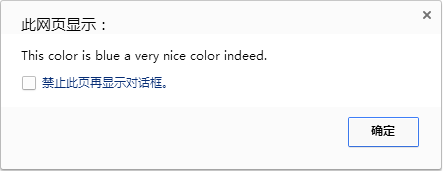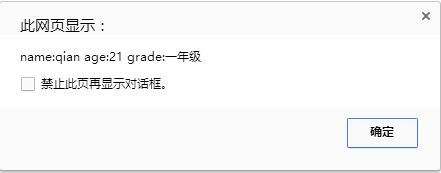JS中的call()和apply()方法详解
来源:互联网 发布:java 堆内存 编辑:程序博客网 时间:2024/05/19 06:49
参考文章:JS中的call()和apply()方法
1.方法定义
call()方法:
语法:call([thisObj[,arg1[, arg2[, [,.argN]]]]])
定义:调用一个对象的一个方法,以另一个对象替换当前对象。
说明:
call 方法可以用来代替另一个对象调用一个方法。call 方法可将一个函数的对象上下文从初始的上下文改变为由 thisObj 指定的新对象。
如果没有提供 thisObj 参数,那么 Global 对象被用作 thisObj。
apply()方法:
语法:apply([thisObj[,argArray]])
定义:应用某一对象的一个方法,用另一个对象替换当前对象。
说明:
如果 argArray 不是一个有效的数组或者不是 arguments 对象,那么将导致一个 TypeError。
如果没有提供 argArray 和 thisObj 任何一个参数,那么 Global 对象将被用作 thisObj, 并且无法被传递任何参数。
2.使用例子
function sayColor(sPrefix,sSuffix){ alert(sPrefix+this.color+sSuffix);}var obj=new Object();obj.color="blue";sayColor.call(obj,"This color is "," a very nice color indeed.");
function Person(name,age){ this.name=name; this.age=age;}function Student(name,age,grade){ Person.apply(this,arguments); this.grade=grade;}var student=new Student("qian",21,"一年级");alert("name:"+student.name+" age:"+student.age+" grade:"+student.grade);
3.深入理解
a
function add(a,b){ alert(a+b);}function sub(a,b){ alert(a-b);}add.call(sub,12,5);//17这个例子中的意思就是用 add 来替换 sub,add.call(sub,3,1) == add(3,1) ,所以运行结果为:alert(4); // 注意:js 中的函数其实是对象,函数名是对 Function 对象的引用。
b
function Animal(){ this.name="Animal"; this.showName=function(){ alert(this.name); }}function Cat(){ this.name="cat";}var animal=new Animal();var cat=new Cat();animal.showName.call(cat,",");//cat//animal.showNamw.call(cat,[]);call 的意思是把 animal 的方法放到cat上执行,原来cat是没有showName() 方法,现在是把animal 的showName()方法放到 cat上来执行,所以this.name 应该是 Cat
c
function Animal(name){ this.name=name; this.showName=function(){ alert(this.name); }}function Cat(name){ Animal.call(this,name);}var cat = new Cat("Black Cat"); cat.showName(); Animal.call(this) 的意思就是使用 Animal对象代替this对象,那么 Cat中不就有Animal的所有属性和方法了吗,Cat对象就能够直接调用Animal的方法以及属性了.
d
function Class10() { this.showSub = function(a,b) { alert(a-b); } } function Class11() { this.showAdd = function(a,b) { alert(a+b); } } function Class2() { Class10.call(this); Class11.call(this); } 很简单,使用两个 call 就实现多重继承了。
与this结合使用的用法
call和apply都可以改变this指向。
var test = "Tony";var myobj = { test: "Tom"};function doSomething() { alert(this.test);}doSomething();=doSomething.call(); // 弹出 window.test ,即 "Tony"doSomething.call(myobj); // 这个时候,doSomething函数里的this指向 myobj,//所以弹出的是 myobj.test 即 "Tom"总结
注意到,call()与apply()的区别:功能一样。第二个参数形式不一样。call传递多个参数,是任意形式。apply第二个参数必须是数组形式。
用代码来理解它们区别最好:
a.call(b,2,3); ==> a.apply(b,[2,3]);//数组形式传入
就是利用了apply参数是数组的特性。结合函数的隐性参数,都会自动保存在arguments数组中。这样,使用apply的方式:
this.initialize.apply(this, arguments);
可以直接将当前函数的arguments数组作为apply的第二个参数传入,不需要转化。
- js中的apply()和call()方法详解
- JS中的call()和apply()方法详解
- js apply和js call方法详解
- js apply和js call方法详解
- js apply和js call方法详解
- JS中的call、apply、bind方法详解
- Js apply方法 和 call 方法详解
- JS中的apply方法和call方法
- js 中的 call() 方法 和 apply()方法
- JS call 和 apply方法详解
- js中的call()和apply()方法
- JS中的call()和apply()方法
- JS中的call()和apply()方法
- JS中的call()和apply()方法
- JS中的call()和apply()方法
- JS中的call()和apply()方法
- JS中的call()和apply()方法
- JS中的call()和apply()方法
- C语言常用函数------/*自己总结*/
- 1008. 数组元素循环右移问题 (20)
- 量子计算原理
- java.lang.UnsatisfiedLinkError: no cplex1251 in java.library.path
- 什么?吴宗宪在淘宝帮你买买买?
- JS中的call()和apply()方法详解
- 批处理在TXT文本每一行的行首和行尾插入指定字符串
- IntelliJ IDEA 快速入门指南
- 全面的介绍retrofit的文章
- 分布式Session的几种实现方式
- PAT (A )1004. Counting Leaves (30)
- VMware中Centos中启动停止nginx的三种方法
- B+/-树
- tomcat 学习一


